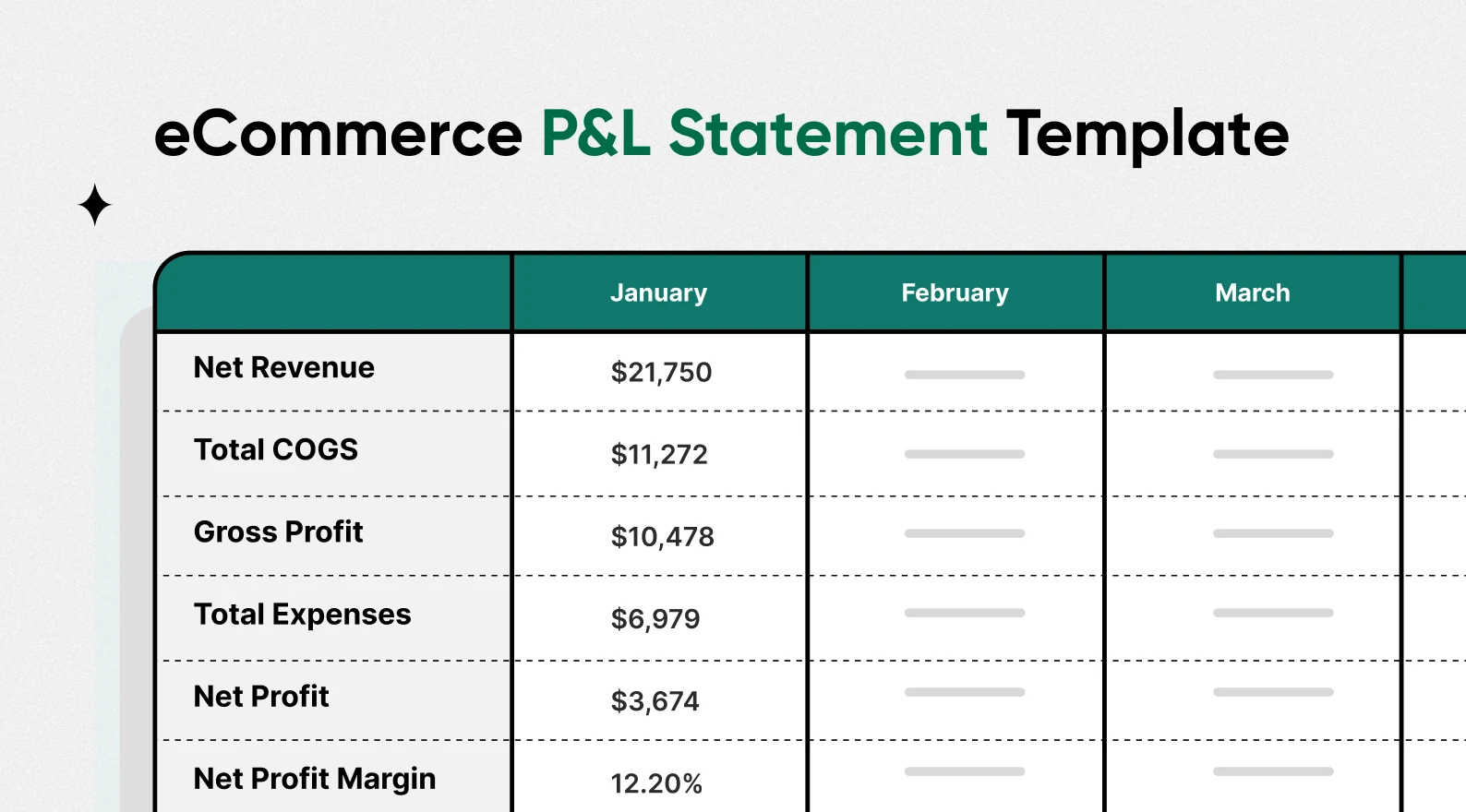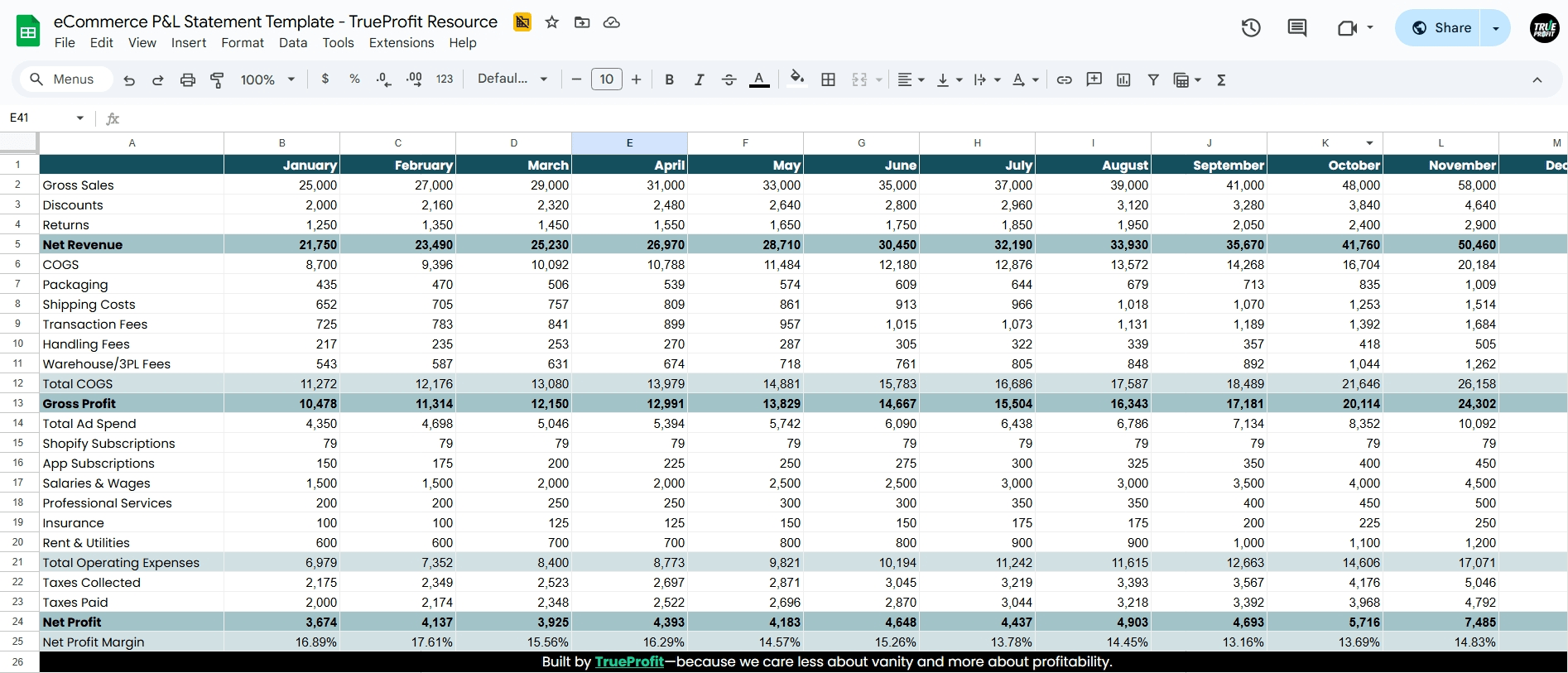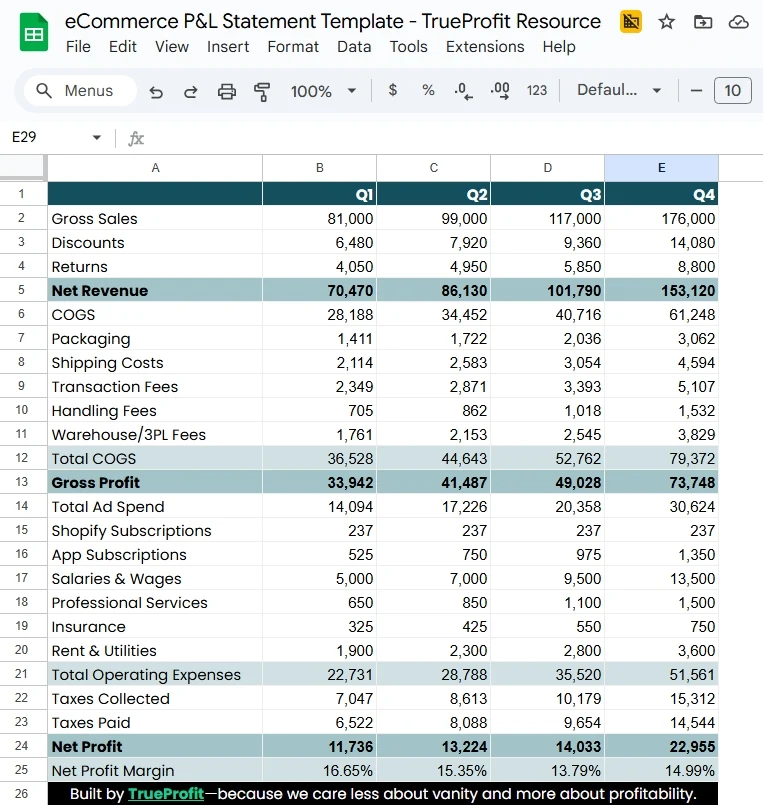Free P&L Statement Template for eCommerce (Google Sheets)

Yes, I want this guide!
Just drop your name and email below—we’ll send the guide your way. No fluff, just real stuff to help you make (and keep) more profit.
Many eCommerce entrepreneurs focus on sales figures, but a high-revenue month doesn’t automatically mean a healthy bottom line. To understand the true financial health of your store, you need a profit and loss (P&L) statement.
In this post, we’ll break down what a P&L statement is, how to make it work for your eCommerce business—and introduce you to our ready-to-use P&L statement template you can use for free.
What is a Profit and Loss Statement?
A profit and loss (P&L) statement, also known as an income statement, is a financial report that summarizes your business's revenues, costs, and expenses over a specific period. It helps you evaluate your store’s true profitability and understand what’s driving or draining your bottom line.
You can use a P&L statement to:
- Track your revenue and costs monthly, quarterly, or annually
- See where your business is making or losing money
- Present financials to partners, investors, or accountants
- Make smarter decisions based on actual profit, not just top-line sales
It’s one of the simplest yet most important tools to stay financially in control.
Download Your Free P&L Statement Template
Building a P&L template from scratch takes time—and if you get the formulas wrong, your numbers won’t add up. So we made one for you.
It’s free, simple to use, and built specifically for eCommerce businesses—especially those on Shopify.
Simply fill out the form in this page to download it.
How to Use TrueProfit’s P&L Statement Template
Our template is designed to be flexible, so you can adapt it to fit your specific needs. Here’s how you can modify the current template for different use cases.
Monthly P&L Statement
Tracking your profit and loss on a monthly basis gives you a consistent rhythm for reviewing financial performance. It helps you spot patterns, track progress, and compare how your store is doing month over month.
In our P&L Statement Template, there’s a dedicated sheet called “P&L Statement (Monthly)” where every metric is organized into monthly columns.
All you need to do is fill in the white cells; the colored ones contain built-in formulas that auto-calculate your totals and margins, so make sure not to overwrite them.
Quarterly P&L Statement
While monthly tracking helps you stay close to the numbers, looking at your profit and loss quarterly gives you a bigger-picture view. It’s perfect for reviewing long-term trends, assessing strategy, and making decisions with less noise from short-term fluctuations.
In our P&L Statement Template, there’s a separate sheet called “P&L Statement (Quarterly)” where you can review your performance across Q1, Q2, Q3, and Q4.
You don’t need to manually total each month because quarterly data is automatically pulled and summed from the monthly sheet.
P&L Statement for Small Businesses
Running a small business means keeping a close eye on what’s working and what’s not. When budgets are tight and resources are limited, having a clear picture of your profit can help you avoid costly mistakes and make smarter calls.
Our P&L statement template makes it easy to stay on top of your numbers. You can add or remove rows as needed—just make sure the formulas still capture your changes so the calculations stay accurate.
P&L Statement for eCommerce Businesses
With all the moving parts in eCommerce, it’s easy to lose track of what you’re actually making. Our eCommerce P&L template helps you stay grounded. It covers key line items like COGS, fulfillment, ads, platform fees, and more—so you can see your true profit after all costs & expenses.
Like we mentioned earlier, feel free to add or remove rows to fit your business. Just remember to update the formulas to keep your numbers accurate.
Bonus: P&L Statement for a Specific Product Line
Want to know if a certain product line is truly profitable? You can use our template for that too. Just make a copy and fill it out using only the revenue and expenses tied to that product line.
It’s a simple way to spot which products are worth doubling down on and which ones might be dragging down your margins.
Components of a P&L Statement Template
Our P&L template follows a logical flow that mirrors how money moves through your business. Here's what you’ll find inside:
Revenue Section
This top section shows all money coming into your business:
- Gross Sales: Your total sales before any deductions
- Discounts: Promotional codes and sales discounts you've offered to customers
- Returns: Product returns and refunds processed through your store
- Net Revenue: Your actual revenue after discounts and returns
Total Cost of Goods Sold (Total COGS)
Total COGS represents the direct costs of fulfilling orders. This includes but is not limited to: COGS, packaging materials, shipping to customers, payment processing fees, handling costs, and any warehouse or 3PL fees.
Gross Profit
This crucial metric shows your profit before operating expenses. It tells you if your core business model is profitable.
Operating Expenses
Operating expenses include but are not limited to your ad spend, Shopify subscription, app subscriptions, salaries and wages, professional services, insurance, and rent or utilities. These costs keep your business running whether you make 10 sales or 1,000 sales in a month.
Tax Calculations
- Taxes Collected: Sales tax collected from customers (a liability, not income)
- Taxes Paid: Income tax and other business taxes owed
Bottom Line Metrics
- Net Profit: The final number at the bottom of the statement. This is your gross profit minus all operating expenses.
- Net Profit Margin: Net profit as a percentage of total sales. This percentage reveals your business's true profitability.
Why is a P&L Statement So Important?
A profit and loss statement is more than just a financial report. It's a strategic tool for business growth. Here’s why every eCommerce business needs one:
- Identifies profitability: It gives you a clear picture of whether your store is turning revenue into profit.
- Highlights areas for improvement: By breaking down your expenses, the P&L statement helps you pinpoint where you might be overspending.
- Informs business decisions: A strong understanding of your finances allows you to set smarter prices, manage your inventory more effectively, and allocate your budget where it will have the biggest impact.
- Simplifies financial planning: With a clear view of your past performance, you can create more accurate budgets and financial forecasts for the future.

Marketing Manager at TrueProfit
Lila Le is the Marketing Manager at TrueProfit, with a deep understanding of the Shopify ecosystem and a proven track record in dropshipping. She combines hands-on selling experience with marketing expertise to help Shopify merchants scale smarter—through clear positioning, profit-first strategies, and high-converting campaigns.







